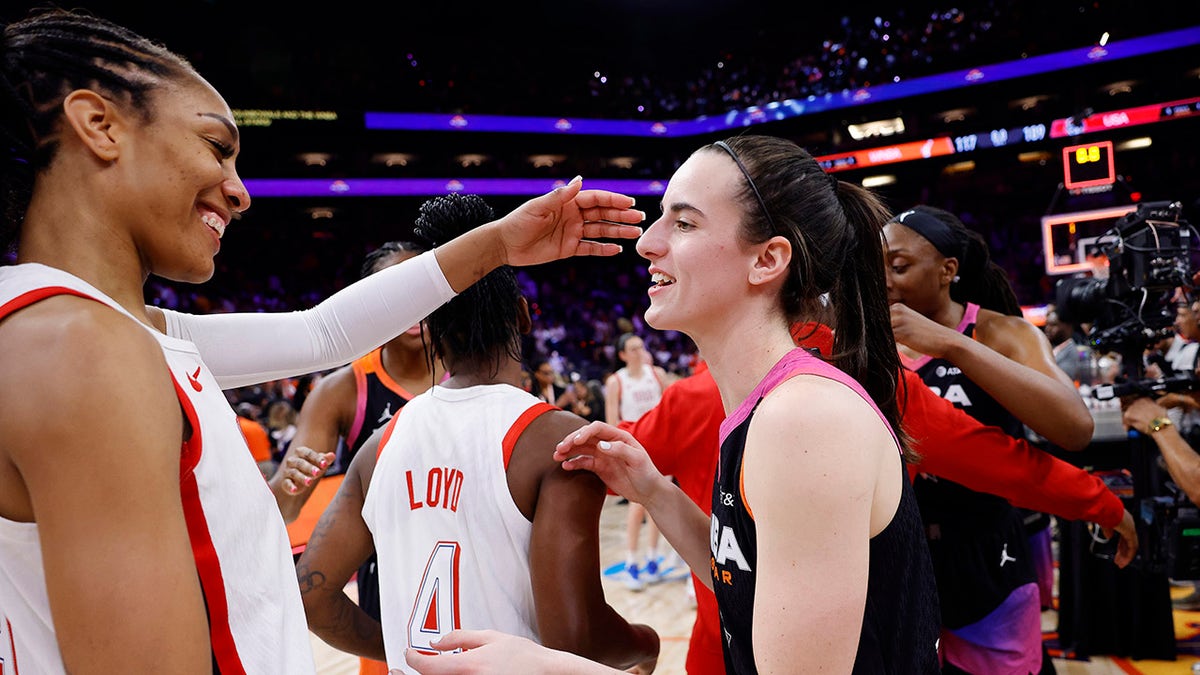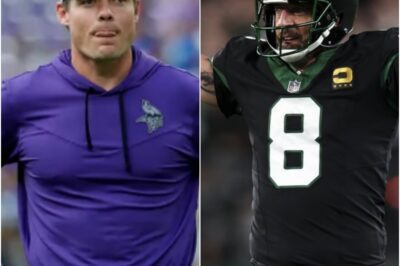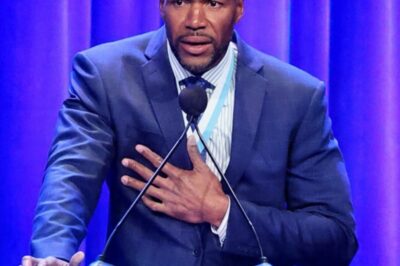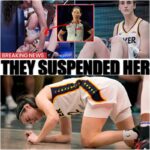EXPLOSION AT THE WNBA: Leaked Footage of Caitlin Clark Incident FORCES Emergency Referee Suspension — What the League Didn’t Want You to See Is Now Out A shocking leak just turned the WNBA upside down. Raw, unedited footage tied to Caitlin Clark’s brutal injury has surfaced—and it’s worse than anyone imagined. Within hours, league officials scrambled, one referee was suspended, and now fans are asking: Was this just bad officiating, or part of something bigger the league tried to hide? The cover-up whispers are growing louder…

On what should have been just another night of intense basketball, the WNBA changed forever.
Caitlin Clark—a rookie phenom, an icon in the making, and the face of a new generation of fans—had just crossed half-court during the third quarter of a high-stakes game between the Indiana Fever and the New York Liberty. The air was thick with tension. Every possession mattered. The arena buzzed with energy as Clark surged forward, cutting through defenders with her signature quickness.
But then—one step. One collision. And everything stopped.
Clark collapsed. The arena went silent.
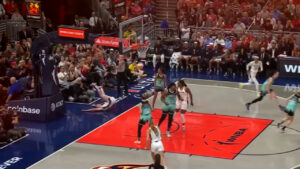
What happened in the seconds that followed has since become the most scrutinized moment of the WNBA season. But it wasn’t just the injury that sparked outrage—it was what happened after. And what didn’t happen. A silence, not just in the arena, but from the referees, the league office, and for a while… everyone.
Until the video leaked.
The Play That Changed Everything
Let’s start with the facts. The Indiana Fever, struggling for momentum, were tied with the powerhouse Liberty in the final minutes of the third quarter. Clark, with 15 points already on the board, was pressing the lane. Sabrina Ionescu stepped up defensively. The moment they collided, it was clear something was wrong.
Clark didn’t bounce back up.
She clutched her knee, grimaced in pain, and didn’t even try to move. The medical staff rushed in. Her teammates surrounded her, some with hands over their mouths, others with fury on their faces. The Liberty players stood in stunned silence. Even Ionescu looked shaken.
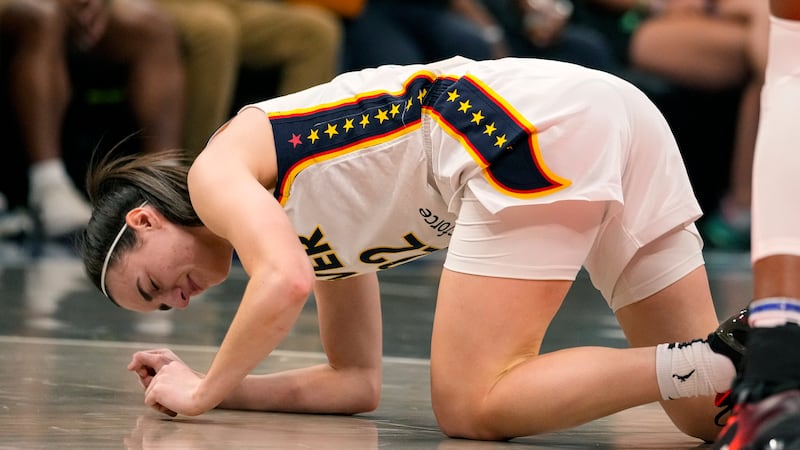
Referees huddled. They watched a quick replay. And then… nothing. No foul. No flagrant. Not even a whistle for excessive contact.
The game resumed. The Liberty won.
But the mood in the arena had turned cold. Something didn’t sit right.
The Silence — Then the Leak
Hours later, social media erupted.
A fan’s courtside video—raw, uncut, and taken from a completely different angle—began circulating online. It clearly showed the play. The footage wasn’t blurry. It wasn’t speculative. It showed Ionescu stepping into Clark’s path, making forceful contact with her lead leg. Clark’s knee twisted awkwardly as she fell.
It was not a flop. It was not incidental. It was a dangerous, high-risk collision—and it hadn’t even drawn a whistle.
Within minutes, the clip went viral. Within hours, outrage began to swell.
The League Responds—Too Late?
By morning, #JusticeForClark was trending on X. Commentators from ESPN, fans from both camps, and even NBA stars weighed in.
The WNBA issued a statement late the next day:
“The safety of our players is our top priority. We are conducting a full review of the incident involving Caitlin Clark. Our thoughts are with her, and we are committed to ensuring accountability and fairness on the court.”
But that wasn’t enough to quell the storm.
Because by then, it had already leaked that one of the referees from that game had been quietly suspended pending internal review. The league hadn’t announced it. It was discovered through back channels—and that secrecy only made things worse.
Now, the question wasn’t just whether Clark had been fouled.
The question was whether the league had tried to cover it up.
A League Under Fire
The response from players was swift.
A’ja Wilson, Clark’s teammate and reigning MVP, tweeted bluntly:
“That wasn’t just ‘physical play.’ That was dangerous. We have a right to protection, just like anyone else.”
Brittney Griner commented, “You can’t talk about growing the league while letting stars get hurt like this.”
Even WNBA veterans like Sue Bird and Diana Taurasi, who had rarely weighed in on league officiating, expressed concern. “We’ve all had hard falls,” Taurasi said, “but you know when the whistle doesn’t blow because someone’s scared to call it? That’s when it’s a problem.”
Sabrina Ionescu, caught in the center of the controversy, eventually addressed the media.
“I didn’t mean to hurt anyone,” she said. “It was a heat-of-the-moment play. I’m not a dirty player. But I understand the criticism. I wish Caitlin a full and fast recovery.”
The Referee’s Suspension and What It Meant
Days later, the WNBA confirmed what fans already suspected: one of the officials from the Clark incident had been formally suspended. The league promised an independent investigation into both the incident and its own response.
The language of the statement was striking:
“In light of the seriousness of the allegations and the league’s commitment to fairness, the WNBA is placing the official in question on administrative leave. We will be working with a third-party panel to assess officiating standards and processes moving forward.”
That kind of language—“allegations,” “administrative leave,” “third-party panel”—was new. And serious.
Sources inside the WNBA later confirmed that the review would also look into whether certain teams and players were receiving more lenient treatment from referees during key games. It wasn’t just about Caitlin Clark anymore.
It was about whether the league was protecting its image at the expense of its integrity.
The Bigger Picture: Culture, Bias, and What’s Next
In the days that followed, The Athletic and ESPN both published investigative reports alleging inconsistencies in officiating, underreporting of player complaints, and internal pressure not to “overpenalize” star players during televised games.
Privately, several referees admitted to being unsure of how to handle high-profile plays involving Caitlin Clark. “The league wants her to shine,” one ref said anonymously. “But then they tell us to let the game ‘flow.’ You can’t have it both ways.”
The implication? That referees were conflicted and inconsistent, especially when a star player like Clark was involved. The line between protecting the game’s future and applying the rules evenly had blurred.
Clark’s Road to Recovery
As for Clark, her injury was later confirmed to be a moderate knee sprain, not season-ending, but enough to sideline her for several crucial games.
Speaking publicly for the first time since the incident, she said:
“I’m thankful it wasn’t worse. I’m focused on recovery. I love this game, and I want it to be safe—for everyone.”
Her words struck a chord. They weren’t angry. They were measured. But they were powerful.
The Fever Fight On
Without Clark, the Indiana Fever struggled. Their offense slowed, their playoff chances dipped, and morale was tested.
But something else happened too: fans kept showing up. Teammates stepped up. And Clark, even while sidelined, was visible—on the bench, at practices, and in every team huddle.
Her presence, even in absence, fueled the team’s resolve.
And the fans noticed.
A League at a Crossroads
The WNBA is growing—fast. Record viewership. Sold-out games. Stars getting the recognition they deserve.
But this incident has exposed a deeper tension.
If the league wants to be taken seriously—by fans, by sponsors, by the next generation—it needs more than talent. It needs trust. And trust requires transparency, fairness, and accountability.
The Fallout Isn’t Over
The independent investigation is still ongoing. The suspended referee’s future remains unclear. Clark is back in light workouts, but her full return will take time.
Meanwhile, the league has promised:
Enhanced training for referees
Expanded use of real-time video reviews
A newly formed Player Safety Committee with athlete representatives
A public-facing incident tracker for controversial officiating moments
Whether those steps are enough remains to be seen.
But One Thing Is Clear
That night changed everything.
Not because Caitlin Clark got hurt. Injuries happen in sports. But because when it did, the system that was supposed to protect her… didn’t.
And fans noticed. Players noticed. The whole world noticed.
Now, the WNBA has a choice: learn from it—or let it happen again.
And if there’s one thing Caitlin Clark has taught us this season
News
BREAKING: Karoline Leavitt Just BANKRUPTED The View — And Megyn Kelly’s Response Says EVERYTHING It started with a reckless joke on air. It ended with a courtroom bombshell that left the daytime talk world trembling. As hosts panicked behind the scenes, Megyn Kelly stepped forward—with 12 words that turned everything upside dow
BREAKING: Karoline Leavitt Just BANKRUPTED The View — And Megyn Kelly’s Response Says EVERYTHING It started with a reckless joke…
Jasmine Crockett Loses It After Karoline Leavitt Asks Who Was Controlling Biden And The Tense Exchange Instantly Sets Social Media On Fire
Who’s Really Running America? Caroline Leavitt vs. Jasmine Crockett and the Political Firestorm Shaking Washington A political storm is raging…
VIDEO: Minnesota Vikings HC Kevin O’Connell Drops A Giant Truth Bomb While Revealing Why He Passed On Aaron Rodgers
Kevin O’Connell and Aaron Rodgers (Photo Via Imagn Images) Kevin O’Connell had the chance to bring Aaron Rodgers to Minnesota. He didn’t…
NFL Fans Break Down After Michael Strahan Shares Emotional Family Update
Michael Strahan (Photo by Mike Coppola/Getty Images for The Buoniconti Fund To Cure Paralysis ) Michael Strahan had an emotional…
James Cook Drops Bombshell On Bills Fans After Shocking Breakup With Team
James Cook and his house (Photo Via Imagn Images and X/@BillsBackersROC) It’s no longer just about contracts or skipped practices,…
Everyone Said The Same Thing About Derrick Henry’s Wild Offseason Workout (VIDEO)
Football fans were saying the same thing about a viral video showcasing Derrick Henry’s latest beast mode offseason workout. The two-time NFL rushing…
End of content
No more pages to load

